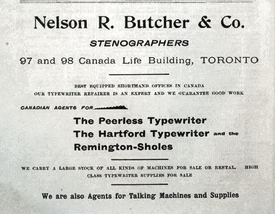|
The Bettini Phonograph in Court
by Robert Feinstein

|
|
Dr. J. Mount Bleyer, ca. 1892
|
|
|
From its inception, Thomas A. Edison
recognized the possibility of phonograph
use in stenography, and he wrote about that
in "The Phonograph and its Future," published in
THE NORTH AMERICAN REVIEW of May-June,
1878. Unfortunately, in the years immediately
after he first intoned "Mary had a little lamb" into
the horn of his tinfoil machine, Edison believed
that his favorite invention would replace, rather
than assist, shorthand reporters. This resulted
in considerable hostility to talking machines by
stenographers through much of the 1880s and
1890s. Indeed, during the initial Meeting of the
Local Phonograph Companies, held in Chicago in
1890, the problem of how to overcome the fear of
many stenographers was a prime topic. During
that conference, a number of prominent figures
in the history of
recorded sound,
most notably
Edward Easton,
founder of both
the American
Graphophone
Company and

|
|
Nelson R. Butcher, ca. 1910
|
|
|
Columbia
Phonograph
Company, and
himself a former
court reporter,
gave assurances to
stenographers that
phonographs would
not endanger their
jobs.
And in 1892, as
attitudes were beginning to change, Lieutenant
Bettini’s close friend, Dr. J. Mount Bleyer, wrote
a widely quoted article for JOURNAL OF THE
AMERICAN MEDICAL ASSOCIATION, "The
Edison Phonograph and the Bettini Micro-
Phonograph," which declared:
"The phonograph
has come much into use as an assistant in
dispatching correspondence, and it is not used in
lieu of, but in connection with the stenographer."
Nelson R. Butcher, official reporter for the
Toronto court system, variously president of the
International Association of Shorthand Writers
(for Canada) and the Canadian Shorthand Society,
who was certainly one of the most well-known
stenographers of his time, eagerly embraced
phonographs early on. And he especially liked
Bettini machines. Relatively little is known
about Butcher’s early life, or how and why he
happened to enter the profession. He was born in
Canada about 1858 and married Lilllian A. Tile in
Hamilton City, on February 7, 1880. The couple
had a son and daughter, the latter of whom was
tragically killed in an accident at Niagara Falls in
1912. Butcher lived until April 6, 1935, and he
died in York, Ontario, at the approximate age of
seventy-six.

|
|
Butcher’s CANADIAN ALMANAC AND DIRECTORY
advertisement of 1897
|
|
|
THE WINDSOR EVENING RECORD of April
15, 1903 and THE CUMBERLAND NEWS of
September 15, 1903 published nearly identical
articles about Butcher’s use of the Bettini Microphonograph
in the Gamey Case, hearings in which
a politician named R. R. Gamey unsuccessfully
claimed that he was bribed to change political
parties. According to THE CUMBERLAND
NEWS:
"Mr. Nelson Butcher, the official
stenographer of the Gamey investigation, has
16 copies of a verbatim report of each day’s
proceedings in the hands of the Court at 10
o’clock of the following day…To reproduce them
in the required time, Mr. Butcher has a staff of 10
or 12 experts, with other professional operators
in reserve. Mr. Butcher himself remains in court
during the proceedings and takes most of the
shorthand…To extend his notes he uses a Bettini
instrument. This is an electrical appliance which
works on something of the same principle as the
[Edison] phonograph…The Bettini attachment
while Mr. Butcher is speaking into it is connected
to successive rollers which reproduce his words…
to two operators on typewriting machines…A few
minutes after these two start working, another
relay begins making copies of their sheets and in
this way 16 copies are completed before midnight.
Mr. Butcher has one or two Bettini instruments
and several typewriting machines in reserve, as a
breakdown with such limited time to work would
be disastrous…"
In all probability, Butcher obtained his Bettini
gear directly from the Lieutenant’s New York
City laboratory, as Nelson R. Butcher and Co.
was known to be selling phonographs by 1897.
Another possibility is that he obtained the Bettini
machines from the music dealer, W. R. Stevens
and Sons Co., also of Toronto, which is known to
have sold Bettini products.
In 1907, the last of the Bettini Phonograph
companies, no longer owned by either Bettini,
his wife, or his in-laws, went out of business.
Butcher may have stopped using Bettini machines
around that time.
|